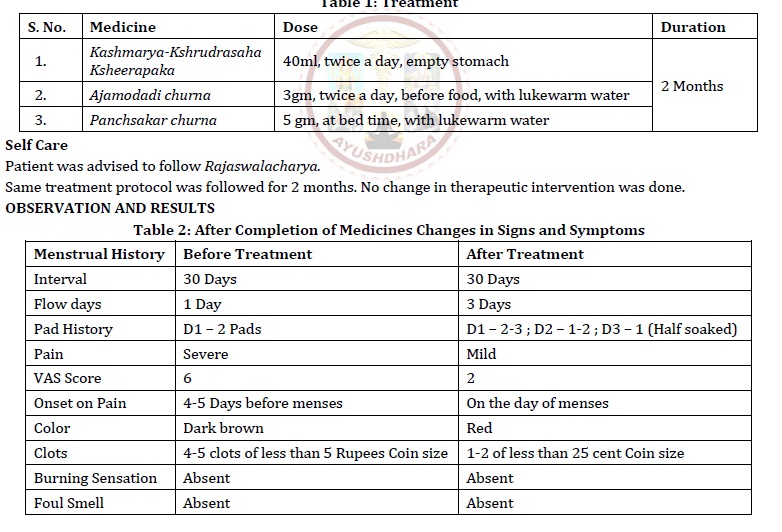Management of Dysmenorrhea due to Ovarian Endometrioma w.s.r to Vatika Artavadushti by Ayurvedic Regime - A Case Report
DOI:
https://doi.org/10.47070/ayushdhara.v9i6.1117Keywords:
Painful, Dark brown colored and scanty menses, Ovarian endometrioma, Vatika artavadushti, Kashmarya-Kshudrasaha Ksheerapaka.Abstract
Endometriomas are cystic lesions that stem from the disease process of endometriosis. Ovary is the most common site for endometriosis (60-70%) and dysmenorrhea is its commonest manifestation. Dysmenorrhea means painful menstruation. Therefore in Ayurveda this condition can be correlated with Vatika Artavadushti as painful menses (Vata vedana) is mentioned as one of the main characteristic feature of it according to Acharya Sushruta. Hereby, reporting a case of 24 year old unmarried female who visited Prasutitantra and Striroga OPD at National Institute of Ayurveda, Jaipur. Main Clinical Findings: Patient presented with the complaints of painful and scanty menses along with vomiting and fever during menstrual days since 1.5 years. Patient also added that she was having dark brown colored menses. Ultrasonography dated 03rd December 2021 suggested bilateral enlarged ovaries with small left ovarian endometrioma. Diagnosis: On the basis of these clinical presentations and ultrasonography findings patient was diagnosed with Ovarian Endometrioma and was further correlated with Vatika artavadushti as mentioned in Ayurveda classics. Intervention: As vitiation of Vata dosha is main causative factor for all these symptoms, treatment of same was of prime importance. Ashtang Sangraha while explaining the management of Vatika Artavadushti have mentioned Kashmarya-Kshudrasaha Ksheerapaka as one of the treatment modality. Hence it was taken as the drug of choice. Outcome: After 2 months of treatment an ultrasound was repeated which showed no any impression of Ovarian Endometrioma. Conclusion: Kashmarya-Kshudrasaha Ksheerapaka is found effective in the management of Ovarian Endometrioma. The purpose of this study is to report the potential of Kashmarya-Kshudrasaha Ksheerapaka in the management of painful menses due to ovarian endometrioma along with its effect on dark brown colored and scanty menses with special reference to Vatika artavadushti.
Downloads

Downloads
Published
Issue
Section
License
Copyright (c) 2022 AYUSHDHARA

This work is licensed under a Creative Commons Attribution-NonCommercial-ShareAlike 4.0 International License.


